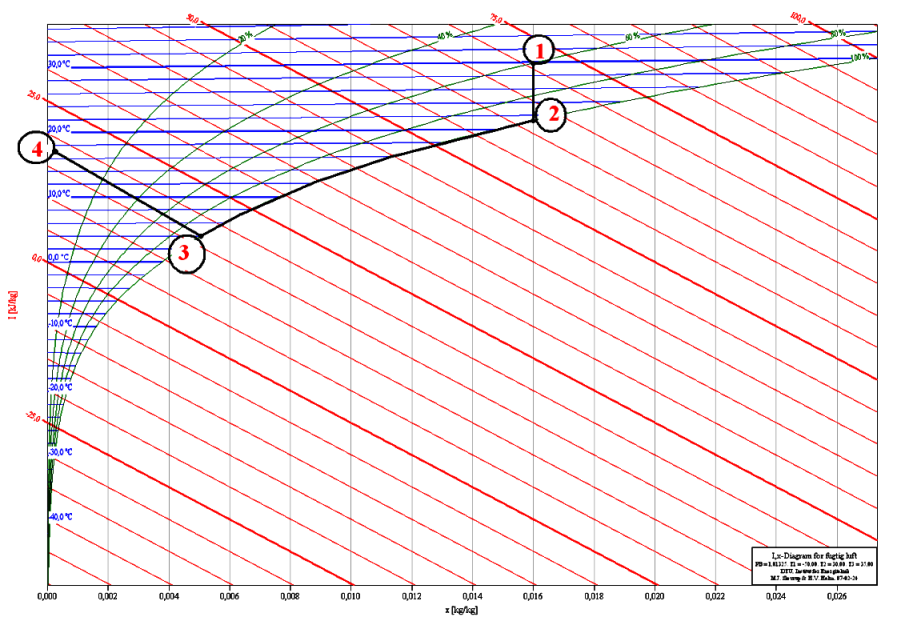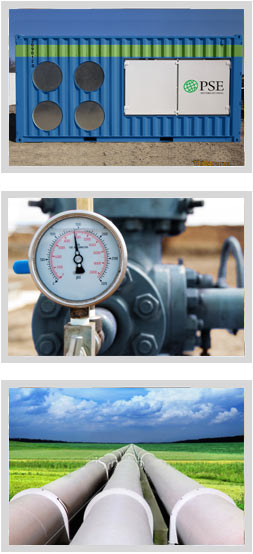PSYCHROMETRIC PRINCIPLES
The principles in the dry air method of drying pipelines are simple. By blowing a low dew point air into the pipeline, moisture will be absorbed in the dry air stream since low dew point air has a low moisture vapour pressure. It is this vapour pressure difference between the air moisture content in the pipeline and the dry air moisture content which is the driving force for drying. The greater the difference, the faster the pipeline will be dried. Since the ground temperature varies, this temperature becomes the determining factor in the length of the drying period because the pipelines are in the ground. Since the pipe wall will be at the same temperature as the ground, the dew point of the air inside the pipe will be at the same temperature of the pipe. Therefore, the air inside the pipeline can content more moisture when the ground temperature is higher. Pipelines can be dried faster when the ground temperature is higher.
To obtain low dew point air, it is necessary to use both refrigeration and desiccant technologies. Figure 1 shows the total dehumidification process. Dehumidification is defined as the removal of moisture from the air. Since ambient air is used in the dry air system, the actual moisture content of the air can vary from low in the winter to very high in the summer.
The first part of the dehumidification process uses refrigeration to chill air below its dew point. In the summer, ambient air has a high temperature and high moisture content, point 1 (Figure 1).
Dehumidification by mechanical refrigeration is very efficient at these conditions. By passing air through the refrigeration cooling coil, which first sensibly cools the air from point 1 to point 2 (Figure 1), moisture is then removed by condensation, from point 2 to point 3 (Figure 1). Normally the air is cooled to approximately 2 degrees Centigrade. Below this temperature, condensed moisture would freeze up on the cooling coil and the dehumidification would stop.
It is very important to the temperature on 20C
Before the air enter the desiccant
The mechanical refrigeration process occurs in a closed, pressurized loop in which a refrigerant such as R134a is circulated through a compressor, condenser, expansion valve and evaporator.
The final part of dehumidification is accomplished by using a desiccant dehumidifier. A desiccant, HPS is used to absorb moisture from the air stream after it passes through the cooling coil. Since the air stream is cool and saturated, the desiccant is very efficient at removing moisture and this reaching the final dew point of -40 degrees Centigrade. This part of the dehumidification process is shown in point 3 to point 4 (Figure 1). Moisture is removed from the air stream in a vapour phase and is not condensed as in the refrigeration process; therefore, the desiccant dehumidification can work at any temperature without freezing up.
HPS is impregnated into a Honeycomb wheel that rotates at 8 to 10 revolutions per hour. The Honeycomb wheel rotates continuously between the process or dehumidifying sector and the regeneration sector. The regeneration sector uses electric heaters to dry out the Honeycomb wheel.
Figure 1: Process air in I-X diagram
 Point 1: Ambient Condition
Point 1: Ambient Condition
Point 1 to 2: Refrigeration (cooling the down to dew point temperature)
Point 2 to 3: Dehumidification by refrigeration
Point 3 to 4 : Desiccant Dehumidification to a dew point -400C to -600C
MOISTURE REMOVAL PERFORMANCE/DRYING TIME
A calculation of the performance of the dry air system and total drying time required was determined:
DRY AIR SYSTEM: Vr = 30.000 m3/h
(OUTLET)
Xout = 0.33 g/m3 (-30 degrees Centigrade dew point)
PIPE WALL TEMPERATURE = 15 degrees Centigrade.
The air dew point inside the pipeline was assumed to be the same pipe wall temperature; therefore, the moisture content of the air was Xm = 12.8 g/m3.
The moisture removal capacity of the dry air system was calculated as:
Vm = Vr(Xm-Xout)/1000
Vm = 30.000(12.8-0.33)/1000 = 374 kg/h
Remaining water in the coated pipeline after successful dewatering which means that the water film is 0.05 mm.
Ex.: 235 km DN 1400 NEL Lubmin to Horst:
Remaining water = W= 3.14/4(D12-D22)*L*1000 = kg water
W = 3.14/4(1.42-1.39992)* 235.000*1000 = 51.700 kg water
The total drying time for this project was calculated as:
T = W/Vm
T = 51.7000/374 = 138 hours or 6 days
LEGEND: Vm = Moisture removal by dry air system (kg/hrs.)
Wr = Dry air volume (m3/hrs.)
W = Amount of water in pipeline (kg)
Xm = Moisture content of saturated air in pipeline (g/m3 air)
Xout = Moisture content of dry air OUTLET (g/m3 air)
D1 = Internal diameter of the pipeline (m)
D2 = D1- 2 times thickness of the water film (m)
1000 = Conversion factor from m3 to kg and from g to kg
TECHNICAL POINTS

We blow dry air through the pipeline by using low pressure system. In this system we dry the air at atmospheric pressure and blow the dry air to the pipeline by roots blower. Maximum pressure for this blower is 1 barg. Most of the pipelines only require a pressure between 0.2 to 1.0 bar to blow and press foam pigs through the pipelines (special pipelines with big diameter).
Upon entering the pipeline, the air has a dew point of -400C or there under.
The dry air absorbs the water in the pipeline due to the difference in partial pressure between the air and the vapours. The temperature of the air in the pipeline determines the amount of water that can be absorbed.
To achieve an efficient drying we need amongst following:
1) High velocity of the because high velocity of the air gives rapidly evaporation
2) Low dew point at inlet
3) High ground temperature
4) Big surface of the water film by using foam pigs to spread the water in the pipelines
Dry air provides effective corrosion protection in the pipeline as a relative humidity of below 50% halts corrosion However; this does not apply to polluted air.
